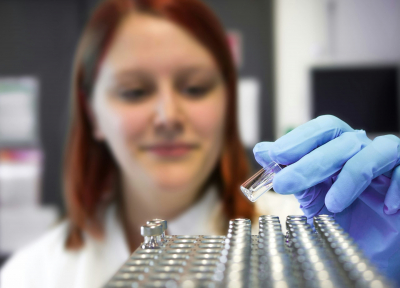Antimicrobial Resistance
Explore the different types of infectious agents that cause disease.
On This Page:
Overview
Antimicrobial resistance, also called antibiotic resistance, is when bacteria evolve ways to survive exposure to antibiotics that used to kill them or inhibit their growth. As more bacteria develop resistance to antibiotics, healthcare providers are running out of ways to treat patients. The impact is incalculable because antibiotics are used to treat infections like staph, but also during routine surgeries, and even for cancer patients undergoing chemotherapy. Immunology research can provide potential solutions for treating antibiotic-resistant infections.
Key Points
- Antibiotics are used to treat bacterial infections when the immune system alone isn’t able to eliminate the invading bacteria quickly or effectively enough.
- Antimicrobial resistance is when bacteria evolve ways to survive exposure to antibiotics that used kill them or inhibit their growth.
- Immunology research can provide potential solutions for treating antibiotic-resistant infections.
How do Antibiotics Work?
Your immune system is designed to detect and destroy harmful pathogens, including bacteria. Antibiotics are used to treat bacterial infections when the immune system alone isn’t able to eliminate the invading bacteria quickly or effectively enough. This may be because the bacteria are growing too fast, the infection is too widespread throughout the body, or a patient’s immune system is weakened such as for people with HIV, chemotherapy patients, or older adults.
Antibiotics specifically target bacteria, without harming human cells, to kill or weaken the bacteria. They can do this by poking holes in the bacteria’s cell wall, preventing the bacteria from making molecules it needs to survive, or preventing the bacteria from replicating. Killing or weakening the bacteria gives the immune system time to catch up and clear the infection. Antibiotics don’t work on viruses and it should not be used for these types of infections.
What is Antimicrobial Resistance?
Antimicrobial resistance occurs when bacteria evolve ways to survive exposure to antibiotics that used to kill them or inhibit their growth. Bacteria develop antibiotic resistance for many reasons including people stopping their antibiotic prescriptions early, taking them when they are not needed, and overuse in food production. Bacterial resistance to antibiotics is a global threat.
Resistance can develop several different ways:
- Mutation: Random changes in bacterial DNA can make them less affected by antibiotics.
- Gene transfer: Bacteria can share resistance genes with each other, even across species.
- Selective pressure: When antibiotics kill susceptible bacteria, resistant ones survive and multiply.
- Develop New Defense strategies:
- Blocking drug entry into the cell.
- Pumping the drug out of the cell.
- Destroying or modifying the drug with enzymes.
- Changing the drug’s target so it no longer binds effectively
Antimicrobial resistant infections can lead to longer illnesses, more hospital stays, and higher medical costs. They can even be life-threatening, especially in vulnerable populations like the immunocompromised or older adults. As antimicrobial resistance becomes a bigger problem, some infections may become untreatable if no effective antibiotics remain.
Immunology Research to Combat Antimicrobial Resistance
Scientists must continually innovate and develop new antibiotics to stay one step ahead of ever-evolving bacteria. However, it’s a constant race—each time a new drug is introduced, bacteria can adapt and develop resistance, making the battle against infection an ongoing challenge.
Therefore, scientists must also find alternatives to antibiotics, which is where immunology research can help. Vaccines are being developed for some bacteria like methicillin-resistant Staphylococcus aureus (MRSA) that have already become resistant to some of our most powerful antibiotics. If successful, these vaccines may eliminate the need for antibiotics altogether for certain diseases.
Developing immuno-antibiotics that can simultaneously strengthen the immune response and weaken the bacteria is another area of research. Other strategies focus on strengthening existing immune defenses against bacteria by enhancing the ability of an immune cell, called a macrophage, could eliminate pathogens like tuberculosis. Scientists have even found ways to use viruses that infect bacteria, and not humans, as a potential treatment for bacterial infections.
The future of fighting antibiotic-resistant bacteria lies in the power of scientific innovation. Cutting-edge approaches like immune-based therapies, next-generation vaccines, and precision-targeted treatments are opening new possibilities in the battle against antibiotic resistant pathogens. These innovations place the immune system at the center of tomorrow’s solutions.
Sources
- Jain, A., Marshall, J., Buikema, A., Bancroft, T., Kelly, J. P., & Newschaffer, C. J. (2015). Autism Occurrence by MMR Vaccine Status Among US Children With Older Siblings With and Without Autism. JAMA, 313(15), 1534. https://doi.org/10.1001/jama.2015.3077
- Taylor, B., Miller, E., Farrington, Cp., Petropoulos, M.-C., Favot-Mayaud, I., Li, J., & Waight, P. A. (1999). Autism and measles, mumps, and rubella vaccine: no epidemiological evidence for a causal association. The Lancet, 353(9169), 2026–2029. https://doi.org/10.1016/s0140-6736(99)01239-8
- Madsen, K. M., Hviid, A., Vestergaard, M., Schendel, D., Wohlfahrt, J., Thorsen, P., Olsen, J., & Melbye, M. (2002). A Population-Based Study of Measles, Mumps, and Rubella Vaccination and Autism. New England Journal of Medicine, 347(19), 1477–1482. https://doi.org/10.1056/nejmoa021134
Related Topics
Downloads
External Resources
Latest News


